Tree Configuration in HRC
Master the art of configuring game trees in HoldemResources Calculator with this comprehensive guide. Learn about key preflop and postflop settings, setting up appropriate bet sizing, and leveraging advanced options to optimize your calculations. Enhance your efficiency using HRC and stay ahead of your competition with well-configured game trees.
Contents
Introduction
No-Limit Hold'em (NLHE) poker is an intricate game, and solving the full version without considerable simplifications is generally infeasible. In NL games, this typically involves limiting the possible bet sizes. For full tables, we often need to simplify the game in other aspects, such as the total number of players actively involved in the pot or the circumstances in which players can flat call instead of just having raise-or-fold options.
In game theory, these artificially limited versions of poker are known as abstract games. Poker solvers compute the solutions for these abstract games, but their results depend on the specified game. If you create an unsuitable game, the solver will provide accurate results for that game, but they won't be practically useful.
This article aims to help you navigate the relevant HRC settings and learn how to construct reliable game tree structures. Before proceeding, you should already know how to set up a new calculation by entering stack and blind values and configuring an equity model. After initiating a new Monte Carlo Hand and configuring the stacks, click Next to reach the Betting Setup dialog page, where you can fine-tune the details of the calculated game tree.
Preflop
This section of the article will provide an overview of the available preflop settings in HRC and offer guidance on how to effectively set them up. There are two options for configuring preflop sizings: A simple version with just the bare basics and an advanced version with more control over the sizings. Both options share a common syntax to define raise sizing and adjustments based on previous actions, such as limps or flat calls.

Sizing Syntax
Preflop sizings can be defined using several format options:
| Format | Description |
|---|---|
| 2.5bb | raise to 2.5bb (bb is optional) |
| 3.0x | raise to 3 times the previous raise amount |
| 75% | raise by 75% of the pot |
| all-in / ai | shove for effective stacks |
| 2.5bb, all-in | combine multiple sizings, separated by comma |
| 2.5bb + 1bb | raise to 2.5bb with a +1bb adjustment added per limp |
| 2.5bb + 1bb + 0.5bb | as above, but add only +0.5bb for each limper after the first one |
| 3.0x + 1.0x | raise to 3x and increase the sizing by 1x for each flat caller |
Tip: Using the bb based format is only recommended for open raises. The pot-percentage or multiplier based formats are preferable for 3-bets, 4-bets and 5-bets, as these actions generally need to be sized in relation to the preceding actions.
Preflop: Simple
The simple preflop configuration closely resembles the interface used in previous HRC versions. It offers limited configuration options and is most appropriate for short-stacked calculations, e.g. when players would only limp, shove or fold.
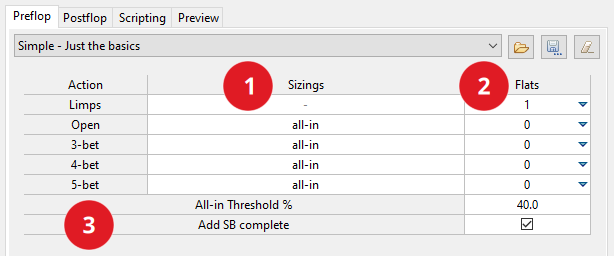
1. General Sizings
The Sizings column defines the sizes for open raises, 3-bets, 4-bets and 5-bets. See the section on Sizing Syntax above for an explanation of the syntax, it can be used to define adjustments for squeezes and isolations.
2. Limps and Flat Calls
The Flats column controls how many players are allowed to limp or flat call. The Limps line defines how many player are allowed to limp, the Opens setting defines how many players are allowed to flat call against an Open raise, and so on.
3. Misc
- All-in Threshold %, replaces a non all-in raise with an all-in if it's larger than x% of the effective stacks.
- Add SB complete, defines whether SB is allowed to complete the blind (regardless of the general limping limit).
Preflop: Advanced
The advanced preflop configuration provides finer grained control over the sizings. Don't feel overwhelmed by the options, most settings are self explanatory and additional information is available via the tooltips. This mode is the recommended option for hands that aren't strictly push-or-fold.
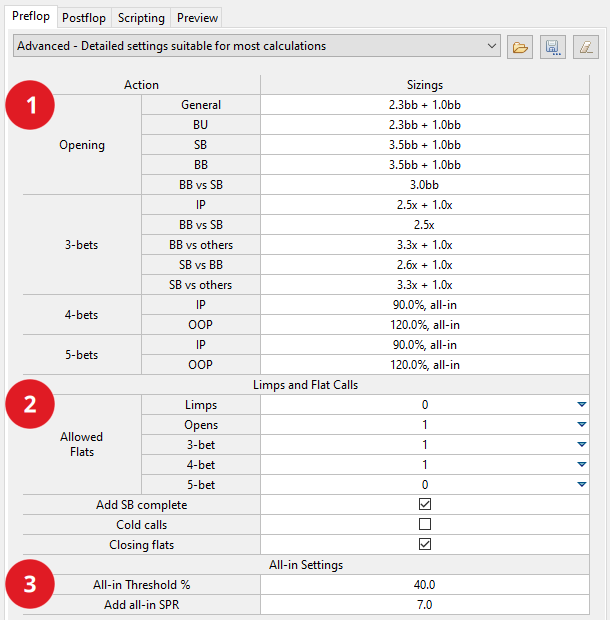
1. General Sizings
The top part of the dialog defines the sizes for open raises, 3-bets, 4-bets and 5-bets. These options are further split up by position. See the section on Sizing Syntax above for an explanation of the format.
2. Limps and Flat Calls
The center part controls when players are allowed to flat call. The first 5 rows of the Limps and Flat Calls section define general flat calling rules. The Limps line defines how many player are allowed to limp, the Opens setting defines how many players are allowed to flat call against an Open raise, and so on.
Allowing additional flat calls will result in more multiway lines postflop and that can quickly grow the size of the game tree. The default values aim to offer a good compromise of tree size vs accuracy.
The following 3 lines define some exceptions to the general rules:
- Add SB complete, defines whether SB is allowed to complete the blind (regardless of the general limping limit).
- Cold calls, if disabled then players are not allowed to flat call a 3+ bet if they didn't previously enter the pot.
- Closing flats, when enabled then flats are always allowed if they close the preflop action.
3. All-in Settings
This section defines some additional rules regarding all-ins:
- All-in Threshold %, replaces a non all-in raise with an all-in if it's larger than x% of the effective stacks.
- Add All-in SPR, automatically adds all-in as a sizing if the stack-pot-ratio is below this value.
Postflop
The postflop stage in poker is where the complexity increases sharply, and having a well-structured game tree is crucial to effective analysis. In HRC, we are generally more concerned with preflop results, and the postflop stage serves primarily to estimate equity realization accurately.
The key is to keep this stage as simple as possible, focusing on ensuring that equities are correctly realized rather than replicating the precise bet sizing found in real games. This section of the article will explore the various postflop settings available in HRC, helping you to better understand and configure these options to enhance the efficiency of your calculations.

Postflop: Off
This setting disables the new postflop model and the calculation will assume that pots are checked down after the flop with no further betting. This is only recommended for push-or-fold calculations or when analyzing specific lines that do not rely on accurate postflop equity realization.
Postflop: Simple
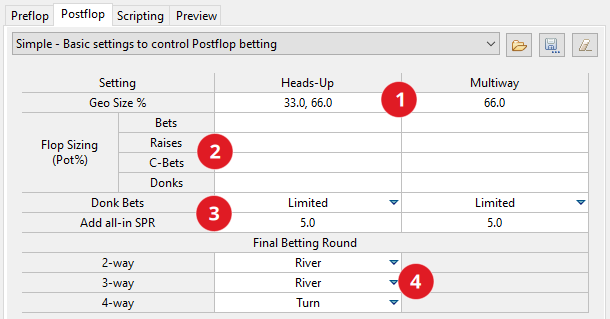
1. Geometric Sizes
The Geo Size % settings for Heads-Up and Multiway are the two most important settings in terms of postflop betting. They are applied to all bets or raises unless otherwise specified and are the only settings to control non all-in bets and raises on the turn and river.
For many calculations it will be completely sufficient to only specify the geometric sizes and leave the flop settings empty. Experiment with adding a second, smaller, geo size for increased accuracy, at least in heads-up pots.
Geometric betting refers to betting a constant percentage of the pot in a way that gets the effective stacks all-in smoothly. Calculations in HRC will often involve many different stack sizes and various preflop lines, so the stack-to-pot ratio (SPR) can vary wildly within a single calculation. Geometric sizing offers a robust way to select bet sizes in this context and avoids wasted nodes with small left-over amounts.
Example:
- We specify 66% as Geo Size and are looking at a line with a SPR of 10.
- For a spot with SPR 10, there are multiple ways to get all-in smoothly: 3 bets @ 88% pot, 4 bets @ 57% pot, 5 bets @ 42%, etc
HRC will pick the geometric size that is closest to the specified percentage. In this example that would be 57% of pot to get stacks in smoothly with 4 bets, since this is the geometric option that is closest to the desired 66%.
2. Flop Sizing
The settings in this section allow finer control over the betting on the flop. As mentioned above, the flop sizings are entirely optional and in general it is fine to only specify Geo Sizes.
- Flop Bets, general sizing for flop bets (defaults to Geo Sizes if empty)
- Flop Raises, sizing for flop raises (defaults to Geo Sizes)
- Flop C-Bets, continuation bets (defaults to general Flop Bets)
- Flop Donks, donk bets (defaults to general Flop Bets)
These flop settings all work with fixed sizes as percentage of the pot.
3. Donk Bets and all-in SPR
Donk Bets: This setting specifies when donk betting is allowed. A donk bet is a bet made before the last aggressor of the previous street has acted on the current street. Limiting donk bets can be an effective way to reduce the tree size.
- Always, donk betting is allowed.
- Limited, donk betting is allowed only if the player made a bet or raise on any previous street.
- Never, donk betting is disabled.
Add all-in SPR: All-in is automatically added as a size option if the stack-pot-ratio (SPR) is below the specified value.
4. Final Betting Round
This section controls the last street when betting can take place, depending on the number of live remaining players in the pot (not counting all-ins). The hand is checked down after the selected street with no further betting. This is another way to effectively control the size of the tree and is especially useful when working with configurations that can result in multiway pots of 4+ players.+
Postflop Abstractions
When dealing with postflop betting, trees can quickly become infeasible in size. HRC uses imperfect recall abstractions to simplify the postflop portion of the game. The related settings can be found in the bottom table.
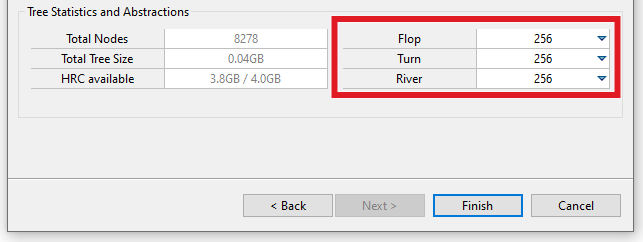
With HRC Classic licenses, abstractions are fixed at 256 buckets. This configuration results in a small tree size and reliable basic accuracy, particularly for scenarios involving short and medium stacks. HRC Pro defaults to 1024 / 256 / 256 buckets for the flop, turn, and river. For enhanced accuracy, we suggest doubling or quadrupling the defaults to 2048 / 512 / 512 or even 4096 / 1024 / 1024.
Generally, it's advisable to use larger abstractions on the flop compared to the turn or river. Flop strategies have the most significant impact on preflop ranges, and increasing the size of the flop abstraction has the least effect on tree size. For most use cases, there's no need to go beyond the 4k abstractions, though 8k and 16k are still available for experimentation.
Preview
The preview tab is a quick way to check the game tree as it is currently defined by your settings. This tab automatically updates whenever you change the tree settings.
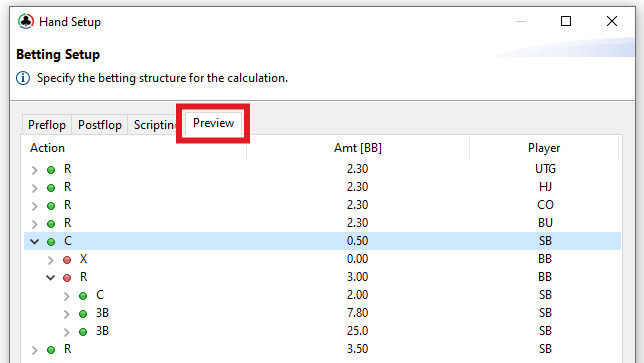
If you are unsure how a specific setting works, make sure to read its tooltip by hovering your mouse pointer over the setting and then utilize the preview tab to experiment with the effects. The preview itself is read-only, you can not modify the tree setup through the preview.
Common Mistakes
Some common mistakes that can easily spoil calculations:
- Switching off postflop betting for hands that utilize flat calls or limps. The calculation then assumes that pots are checked down after the flop. You will see unrealistically wide calling ranges.
- Using non all-in sizes without allowing flat calls. This results in a raise-or-fold game. The weaker part of ranges will be constructed entirely based on card removal. The resulting ranges will rarely be useful in practice.
- Using the postflop mode with empty Geo Sizes. The Geo Sizes are the only settings to control betting on turn and river, you generally don't want to leave these empty.
The Max Active Player Limit
Incorrectly setting the max active player limit is also a frequent cause of problems. The setting is located on the first dialog page of the hand setup at Hand Mode: Max active players. For most scenarios we do not need to consider more than 4 or 5 active players and can safely drop larger multiway lines from consideration without affecting the main ranges. Setting this limit too high will result in wasted memory and computation time.
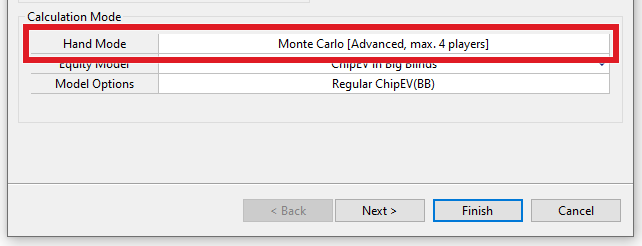
The player limit is enforced before all other tree settings, once this limit is reached all remaining players will be forced to fold regardless of their hand. Keep this in mind when allowing multiple flat calls against opens raises, you don't want the blinds locked out of the hand after an open and a couple of flat calls. To avoid this scenario the max active players setting should be at least 2 plus the number of allowed flat calls against open raises.
Troubleshooting
If you see an error message in the top area of the configuration dialog then this likely has one of the following reasons:
- Exceeding the HRC Classic node limit
- Exceeding the memory limit
In both cases you should check the bottom of the dialog page for more information. You can see the node count and size of the current tree in that area.
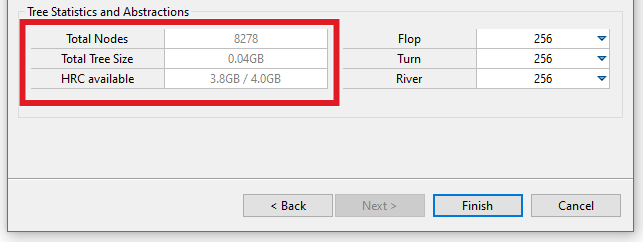
Exceeding the HRC Classic Node Limit
You will see the following error when using a HRC Classic license and setting up a calculation with more than 25,000 nodes.

The classic tier is designed for short to medium stacked calculations. The limit should allow for calculations with the postflop mode up to around 30bb average stacks, if the tree settings are kept simple. For deeper stacks or more elaborate tree configurations please consider upgrading to HRC Pro, which will remove the node restriction.
Some options to reduce the number of nodes:
- Allow fewer flat calls. Multiway postflop pots add a lot of complexity.
- Avoid multiple bet sizings.
- Larger postflop bet sizes result in fewer nodes.
- Reduce the final betting round for multiway pots.
Exceeding the Memory Limit
Messages or warnings like this mean that HRC can't create the hand because there isn't enough free memory available.

Possible solutions:
- Increase the memory limit.
- If you have other hands open then try closing them before starting a new calculation.
- Try reducing the postflop abstraction sizes or simplify the tree.
